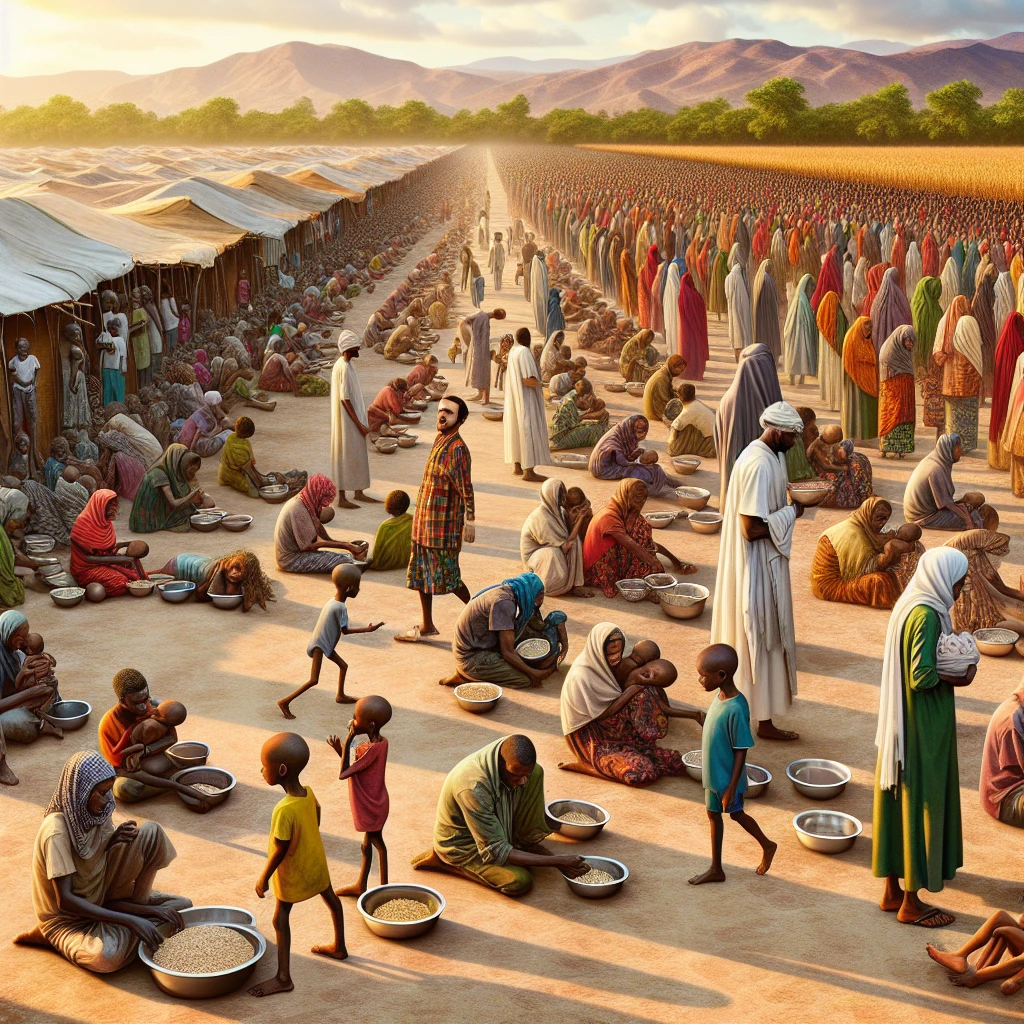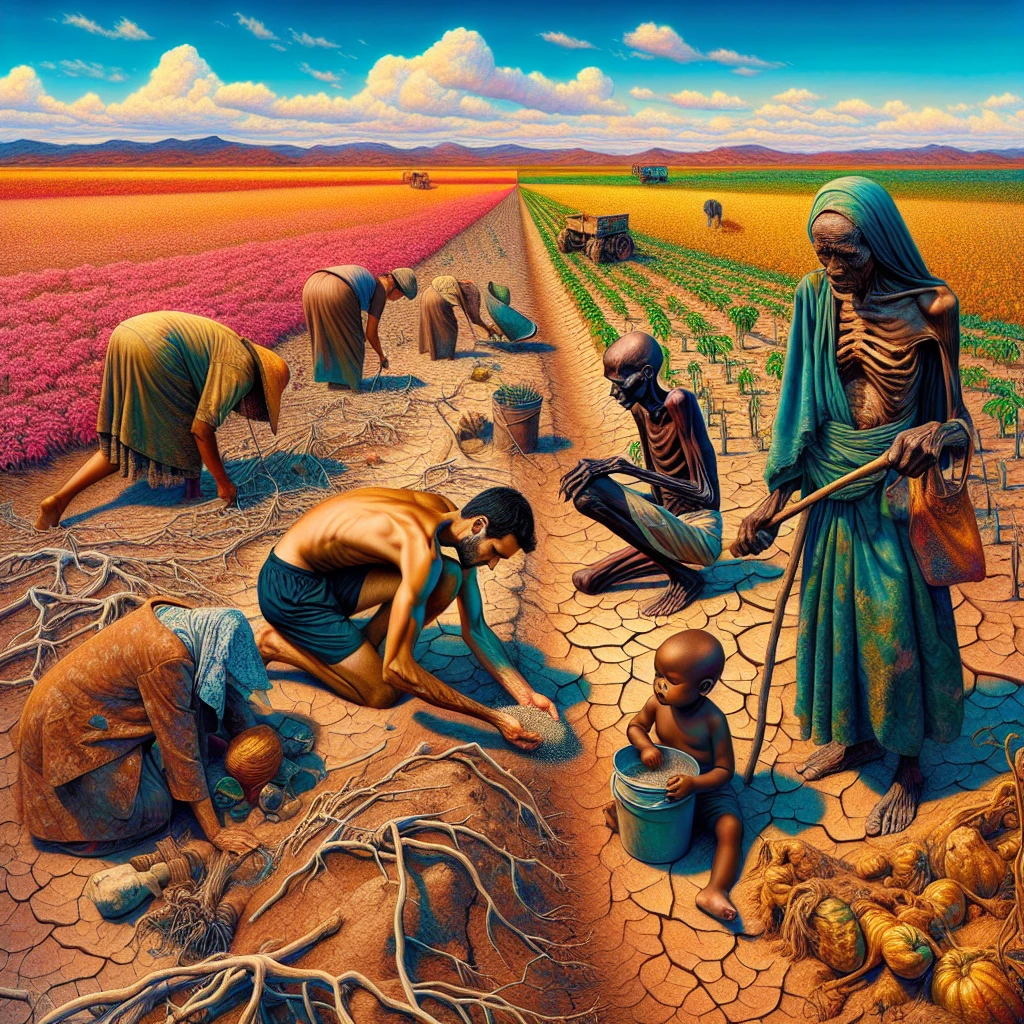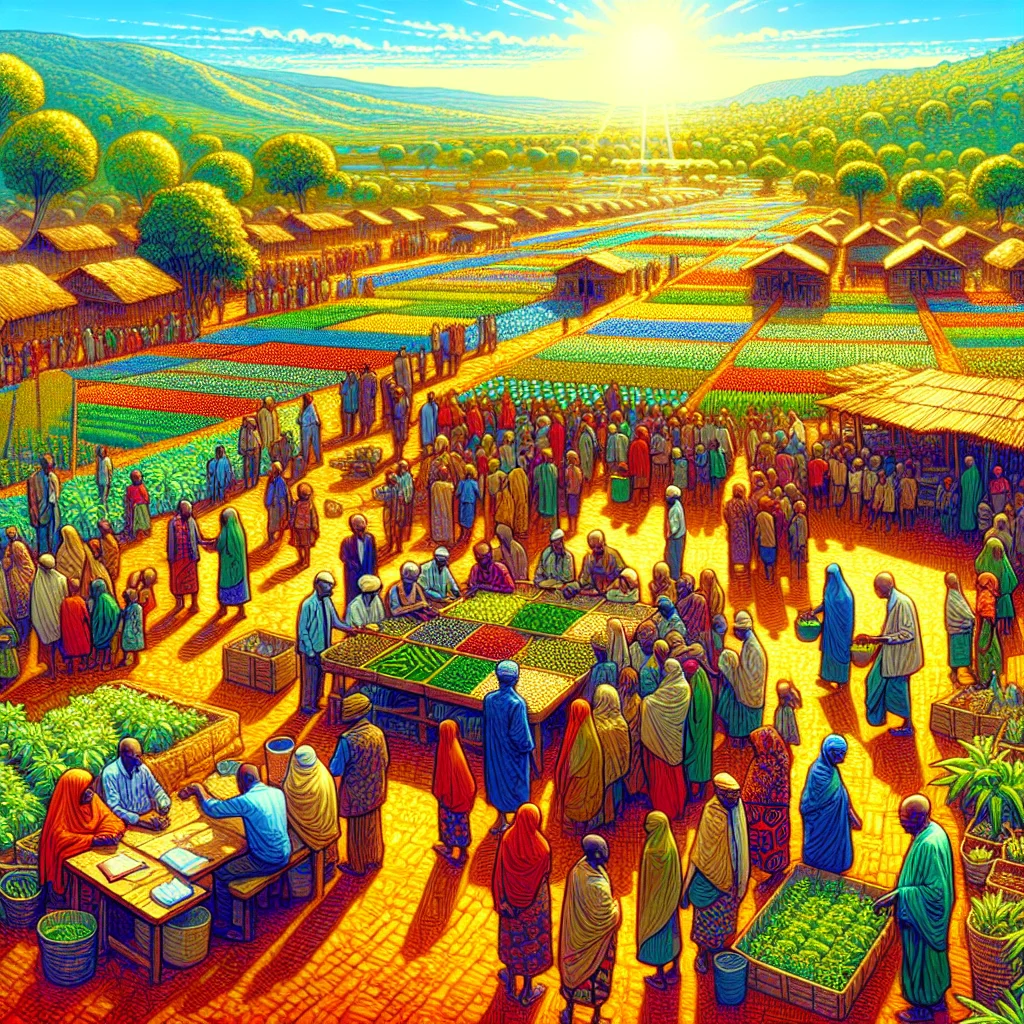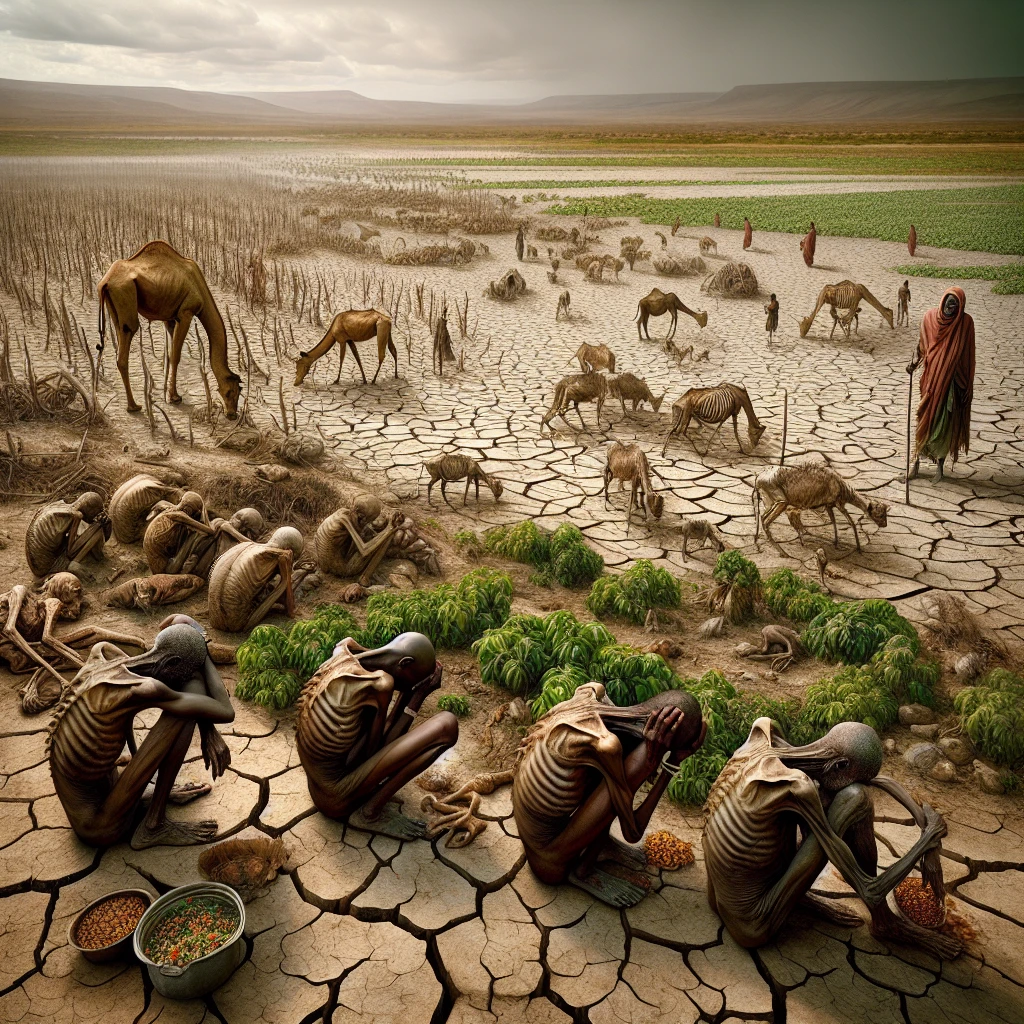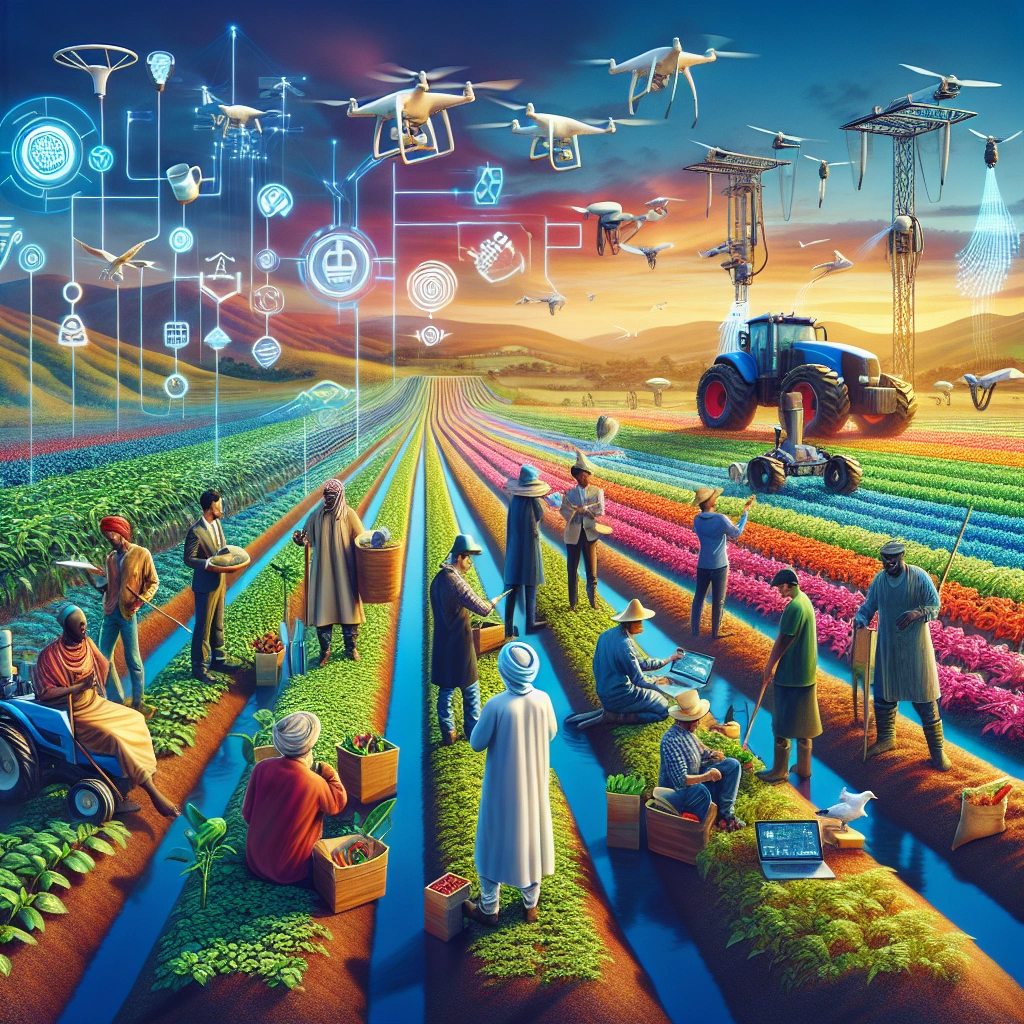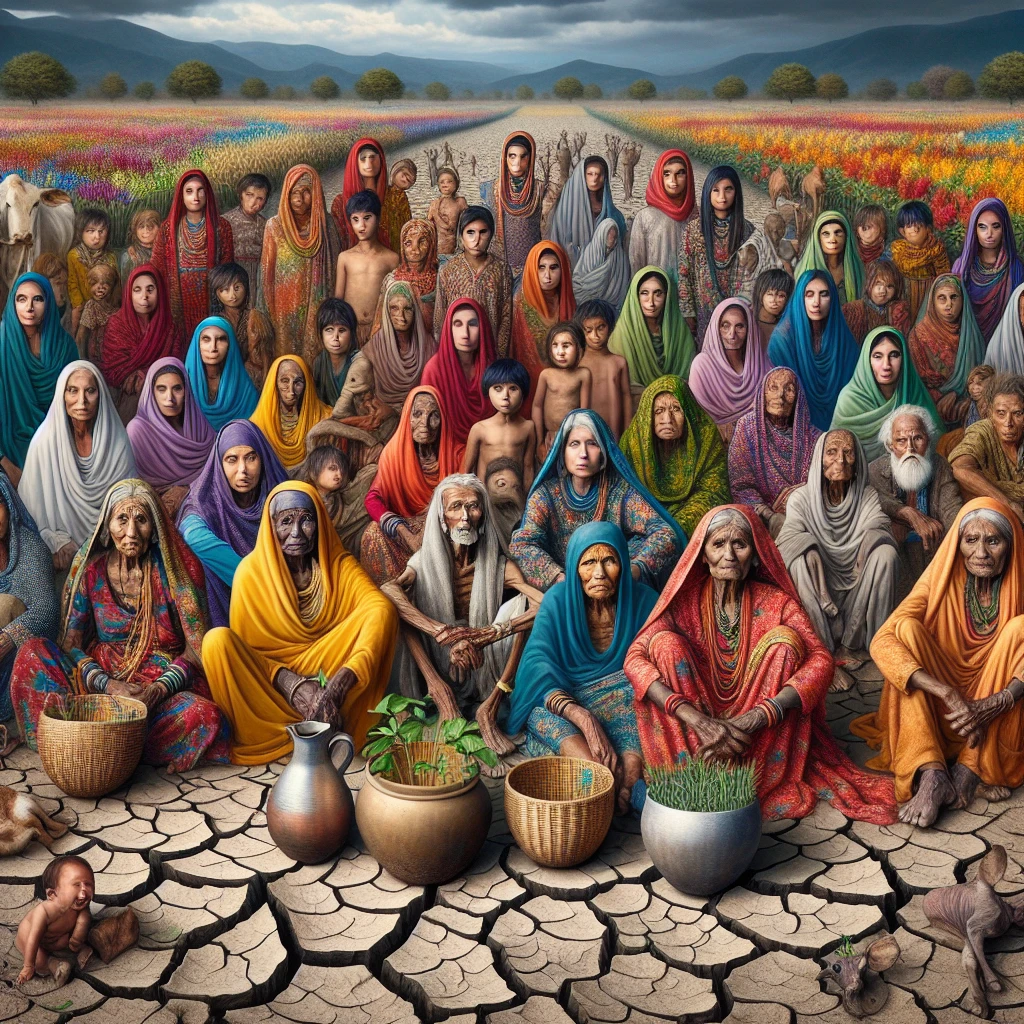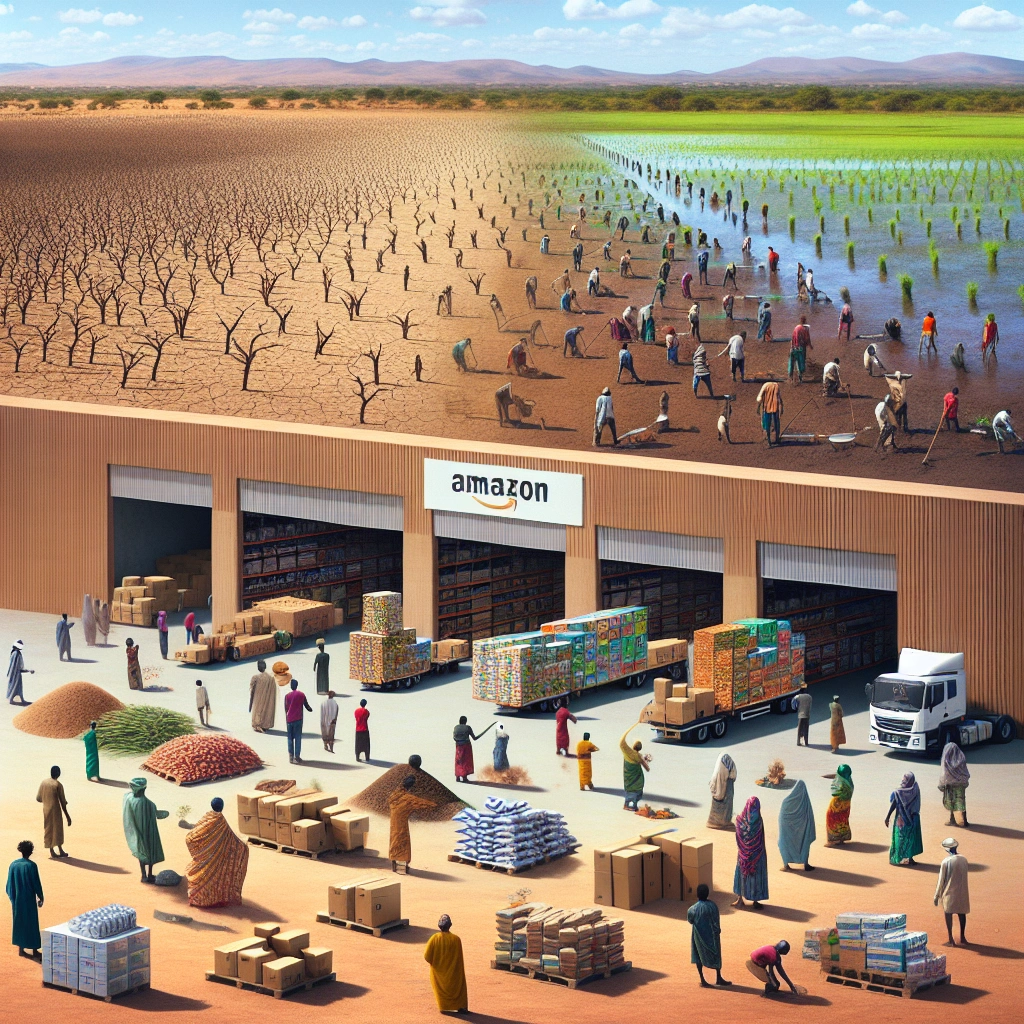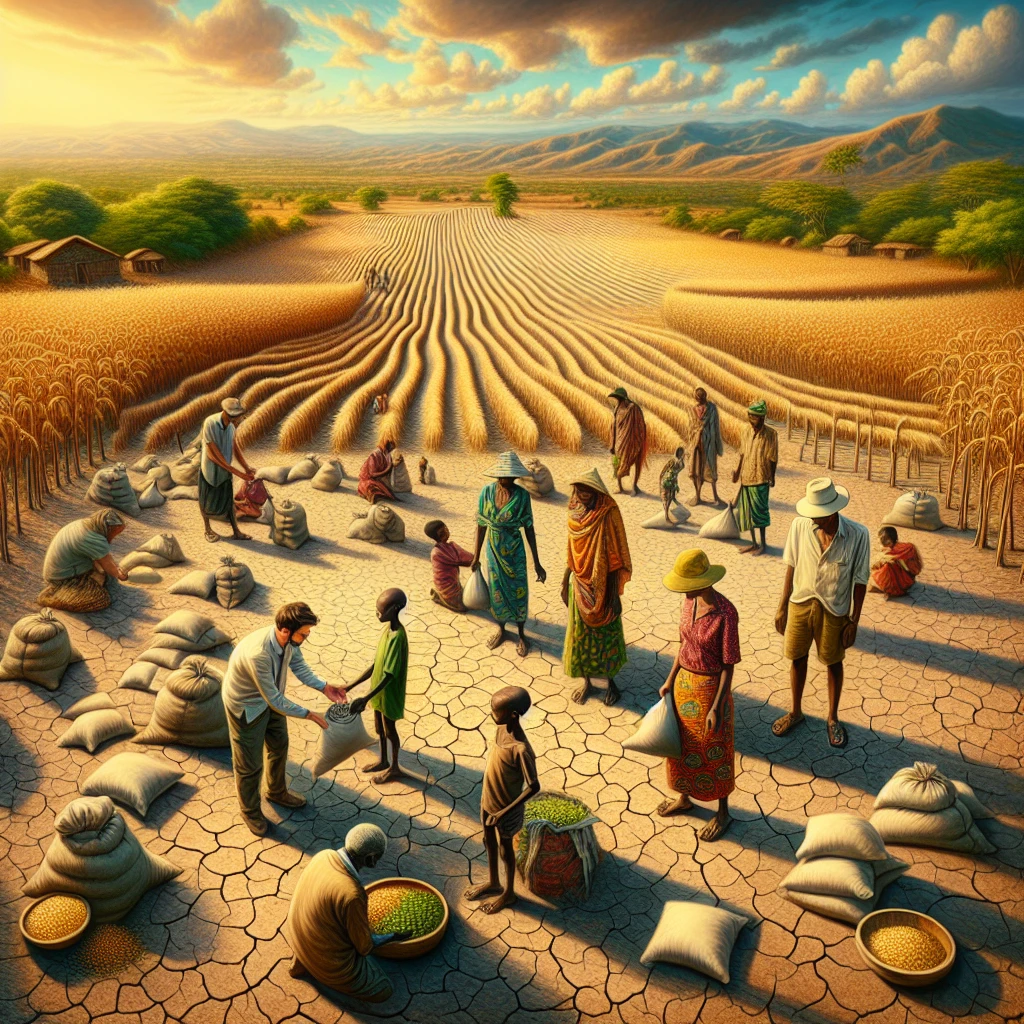

Food shortage refers to the lack of adequate food to sustain a healthy and active life for the population. Sub-Saharan Africa is currently experiencing a severe food crisis, with approximately 146 million people facing acute food insecurity and in need of urgent humanitarian assistance.
Understanding the current food shortage statistics in Sub-Saharan Africa is crucial in addressing the escalating food insecurity across the region and implementing effective interventions to alleviate the crisis.
Check out this Youtube video: “Famine and Food Security in Africa – YouTube” to learn about the current food shortage statistics in sub-Saharan Africa and how it is affecting the region.
The Impact of Food Shortage in Sub-Saharan Africa
Effects on health and nutrition
The food shortage in Sub-Saharan Africa has led to increased malnutrition rates, particularly among children. Malnutrition contributes to high infant mortality rates and causes physical and mental development delays and disorders.
This has long-term effects on work capacity and intellectual performance, resulting in significant health implications.
Economic impact on communities and countries
The economic impact of food shortage in Sub-Saharan Africa is severe, with reduced food supply and higher food prices undermining child nutrition, early childhood development, and educational attainment. Additionally, food distribution discrepancies perpetuate the lack of food, leading to erosion of physical capital as households are forced to sell their assets to buy food.
These economic challenges contribute to long-term consequences for communities and countries.
Social and political implications
Food insecurity in Sub-Saharan Africa has significant social and political implications. Hunger and undernutrition can lead to wasting, stunting, and immunological deficiencies, affecting overall public health.
Moreover, food insecurity creates social disparities, worsens longer-term income and gender inequalities, and can lead to conflicts and tensions within communities. The looming food crisis also poses risks to the political landscape, potentially aggravating existing conflicts and increasing social unrest.
| Impacts | Description |
|---|---|
| Health and Nutrition | Increased malnutrition rates, high infant mortality, delayed development, and long-term effects on work capacity. |
| Economic Impact | Reduced food supply, higher prices, erosion of physical capital, and long-term economic challenges. |
| Social and Political Implications | Wasting, stunting, and immunological deficiencies, social disparities, inequalities, conflicts, and political risks. |
Factors Contributing to Food Shortage in Sub-Saharan Africa
Climate change and its effects on agriculture
Climate change in Sub-Saharan Africa has disrupted traditional weather patterns, leading to unpredictable rainfall and prolonged droughts. These extreme weather events have significantly impacted agricultural productivity, causing crop failures and reduced yields.
As a result, food production has been compromised, leading to food shortages and increased prices in the region.
Land degradation and desertification
Land degradation and desertification in Sub-Saharan Africa have contributed to diminishing arable land and poor soil quality, affecting agricultural productivity. Uncontrolled deforestation, improper land use practices, and overgrazing have accelerated soil erosion, making it challenging to sustain agricultural activities.
These factors have led to the depletion of fertile land, further exacerbating the food shortage crisis in the region.
Political instability and conflict
Political instability and conflict have been key contributors to food shortages in Sub-Saharan Africa. Ongoing conflicts have disrupted agricultural activities, leading to the displacement of farmers and destruction of farming infrastructure.
Additionally, unstable political environments often hinder international aid and humanitarian support, exacerbating the food crisis in the region.
| Factor | Impact |
|---|---|
| Climate Change | Unpredictable weather, reduced crop yields |
| Land Degradation | Diminished arable land, poor soil quality |
| Political Instability | Disrupted agricultural activities |
The combination of these factors has created a complex and challenging environment for food security in Sub-Saharan Africa, requiring coordinated efforts to address the underlying issues and ensure sustainable solutions for the future.
Current Food Shortage Statistics in Sub-Saharan Africa
Overview of current statistics on food shortage in the region
The current statistics on food shortage in Sub-Saharan Africa are dire. Approximately 146 million people are facing acute food insecurity, requiring urgent humanitarian assistance.
This represents a severe and widespread crisis, with a staggering number of individuals struggling to access basic nutrition.
Comparison with previous years’ data
Comparisons with previous years’ data reveal a concerning trend of escalation in food insecurity. Since 2015, food insecurity has been on the rise in Sub-Saharan African countries, exacerbating the already challenging situation.
The percentage of people experiencing food insecurity is anticipated to decrease from 40.5% in 2020 to 24.4% in 2030, indicating a prolonged struggle if effective solutions are not implemented promptly.
Regional and country-specific statistics
Across Sub-Saharan Africa, Middle Africa faces the highest levels of food insecurity, with the situation worsening significantly. Furthermore, the prevalence of food insecurity in Northern Africa, while roughly half that of Sub-Saharan Africa, has also shown a worsening trend from 2020 to 2021. These statistics underscore the urgent need for comprehensive interventions and support to address food shortages in specific regions within the continent.
| Region | Prevalence of Food Insecurity |
|---|---|
| Sub-Saharan Africa | Escalating crisis |
| North Africa | Worsening trend |
| Middle Africa | Highest levels of insecurity |
This table succinctly highlights the gravity of the food shortage crisis in Sub-Saharan Africa and the specific regions facing the most acute challenges.
Remember, it’s not just about numbers and statistics; it’s about the people and communities affected by these alarming trends. With collaborative efforts and immediate action, we can work towards alleviating the food shortage crisis in Sub-Saharan Africa.
The Relationship Between Poverty and Food Shortage
Link between poverty and access to food
Poverty directly impacts access to food, as individuals experiencing poverty often lack the financial resources to afford an adequate, nutritious diet. Limited income levels restrict the ability to purchase quality food, leading to higher susceptibility to food insecurity and malnutrition.
Inadequate access to healthy food options exacerbates the cycle of poverty, affecting overall health and well-being.
Impact of poverty reduction initiatives on food security
Efforts to reduce poverty have a significant positive impact on food security. Poverty reduction initiatives such as employment programs and income support can enhance individuals’ purchasing power, enabling them to afford nutritious food and sustain food security.
Moreover, access to education and skill development opportunities through poverty reduction efforts can empower individuals to improve their economic status, consequently enhancing their ability to access food.
| Poverty Reduction Initiatives | Impact on Food Security |
|---|---|
| Employment Programs | Enhance purchasing power and food accessibility |
| Income Support | Supports individuals in affording nutritious food |
| Education and Skill Development | Empower individuals to improve economic status and access food |
The relationship between poverty and food shortage is evident, highlighting the critical need for targeted poverty reduction initiatives to alleviate food insecurity and promote sustainable access to nutritious food.
Strategies for Addressing Food Shortages in Sub-Saharan Africa
Investment in sustainable agriculture
Investing in sustainable agriculture in Sub-Saharan Africa is crucial to addressing food shortages. By promoting agroecology and regenerative farming practices, we can enhance soil fertility, increase crop yields, and improve resilience to climate change.
For example, supporting smallholder farmers in transitioning to organic farming methods and providing access to essential resources like irrigation systems and drought-resistant seeds can significantly boost food production.
International aid and partnerships
International aid and collaborative partnerships play a vital role in addressing food shortages in Sub-Saharan Africa. By fostering alliances with global organizations, governments, and NGOs, we can leverage resources and expertise to improve food security.
For instance, initiatives like the U. S.-Africa Partnership and the Bill & Melinda Gates Foundation’s support for smallholder farmers demonstrate the impact of international aid in promoting sustainable agricultural development. Engaging in partnerships for technology transfer, knowledge sharing, and investment can enhance agricultural productivity and mitigate the impact of climate change.
Empowerment of local communities and small-scale farmers
Empowering local communities and small-scale farmers is essential for combating food shortages in Sub-Saharan Africa. By prioritizing inclusive agricultural policies, land rights, and access to financial resources, we can enable farmers to thrive and contribute to food security.
For example, implementing initiatives that prioritize small-scale farmers, such as land reform and providing training on climate-smart agricultural practices, can strengthen their capacity to produce food sustainably. Additionally, elevating the voices of local communities in decision-making processes and investing in education and infrastructure can create a more resilient and equitable food system.
| Strategies | Focus |
|---|---|
| Investment in sustainable agriculture | Promote agroecology and regenerative farming practices |
| International aid and partnerships | Foster alliances with global organizations and governments |
| Empowerment of local communities and small-scale farmers | Prioritize inclusive agricultural policies and empower small-scale farmers |
The Role of Government Policies in Alleviating Food Shortages
Analysis of Existing Government Policies
The existing government policies aimed at alleviating food shortages primarily involve federal assistance programs, such as the Food and Nutrition Service and the Emergency Food Assistance Program. These programs target high-risk communities to prevent food insecurity and hunger.
Additionally, localities must expand and improve participation in federal nutrition programs to include all who need them, thereby extending the outreach of such policies.
Case Studies of Successful Policy Implementations
A noteworthy success in policy implementation is the Biden-Harris administration’s commitment to end hunger, as evidenced by the $10 billion commitment to invest in food systems at home and abroad. Moreover, the administration’s actions to reduce food insecurity amidst the COVID-19 crisis, along with the support provided by the American Rescue Plan Act, exemplify successful policy implementations in addressing food shortages.
Challenges in Policy Implementation
While government policies have made significant strides, challenges persist in implementing effective measures to alleviate food shortages. Export barriers and major price shocks exacerbate food insecurity, posing significant hurdles in addressing the food crisis.
Additionally, ensuring justice in the design and implementation of SNAP and other food policies remains a pressing challenge that demands a comprehensive and empathetic approach.
| Programs | Description |
|---|---|
| Food and Nutrition Service | Targets high-risk communities to prevent food insecurity and hunger |
| Emergency Food Assistance | Aids families struggling to put food on the table, particularly amid the COVID-19 crisis |
| Biden-Harris Commitment | A $10 billion commitment to end hunger and invest in food systems at home and abroad |
These insights underscore the critical role of government policies in mitigating food shortages, while also shedding light on the complexities and successes in their implementation.
The Importance of Data Collection and Analysis
Role of accurate data in addressing food shortages
Accurate data is crucial in addressing food shortages as it allows policymakers and organizations to identify regions and populations most in need of assistance. By analyzing data on food availability, household incomes, and nutritional needs, interventions can be targeted effectively.
Accurate data also helps in understanding the root causes of food shortages, such as crop failures or economic instability, enabling informed decision-making.
Methods and tools for data collection and analysis
Various methods and tools are utilized for data collection and analysis in addressing food shortages. These include household surveys, remote sensing technologies, and geographic information systems (GIS) to track agricultural production and food distribution.
Additionally, advanced data analytics and machine learning algorithms are increasingly being employed to process and interpret large datasets, providing valuable insights for proactive interventions.
Examples of successful data-driven interventions
One notable example of a successful data-driven intervention is the use of predictive analytics to forecast crop yields and potential food shortages, enabling preemptive measures such as strategic food stockpiling and efficient supply chain management. Another example is the integration of mobile data collection platforms, which have facilitated real-time monitoring of food distribution and aid delivery, ensuring timely and targeted assistance to vulnerable populations.
Cultural and Social Considerations in Addressing Food Shortages
Traditional food systems and resilience
Historically, traditional food systems have demonstrated remarkable resilience in the face of various challenges. These systems are deeply intertwined with cultural practices and local knowledge, enabling communities to sustain themselves through fluctuations in food availability.
For instance, indigenous agricultural practices such as crop rotation and seed preservation have preserved biodiversity and enhanced resilience, ensuring a consistent food supply even in adverse conditions.
Gender roles and their impact on food security
Gender roles play a significant role in shaping food security. In many societies, women are the primary food producers and bear the responsibility of ensuring food availability within households.
Addressing gender inequality is crucial for improving food security, as empowerment and equal participation of women leads to enhanced agricultural productivity and better nutritional outcomes for families and communities. Women’s active involvement in decision-making processes related to food production and distribution is vital in addressing food shortages.
Community-led solutions and cultural practices
Community-led solutions harness the collective wisdom and solidarity within local communities to address food insecurity. By leveraging traditional knowledge and cultural practices, communities can enhance their self-reliance and sustainability in food production.
For instance, initiatives such as community gardens, seed banks, and agroecological practices rooted in local traditions have proven effective in ensuring food availability and resilience in the face of challenges. Empowering communities through education and awareness about sustainable food practices fosters a sense of ownership and responsibility in addressing food shortages.
| Traditional Food Systems | Gender Roles | Community-led Solutions |
|---|---|---|
| Crop rotation and seed preservation | Empowerment of women in food production | Community gardens and seed banks |
| Indigenous agricultural practices | Women’s involvement in decision-making | Agroecological practices rooted in local traditions |
Embracing the resilience of traditional food systems, addressing gender disparities, and empowering communities through cultural practices are essential steps in mitigating food shortages and ensuring sustainable food security in Sub-Saharan Africa.
The Environmental Impact of Food Shortages
Deforestation and loss of biodiversity
Converting land for agriculture not only destroys natural ecosystems but also threatens the survival of wildlife by depriving them of food sources and shelter. Intensive farming further accelerates biodiversity loss, with agriculture being the primary driver of this impact.
Deforestation, primarily driven by agriculture, significantly contributes to the loss of habitats and disrupts food chains, posing enormous challenges for ecosystems worldwide.
Water scarcity and overexploitation of natural resources
At local and farm levels, water constraints may lead to the utilization of polluted water sources, compromising food supplies and contaminating them. Water shortages directly affect food security, as unsafe water and sanitation can result in malnutrition and exacerbate existing problems.
Scarce or polluted water supplies can hinder agricultural activities, forcing families to divert financial resources and effort to obtain water, thereby impacting their ability to access other necessities and detracting from work or education.
Sustainable food production practices
| Sustainable Practices | Example |
|---|---|
| Drip irrigation | A farm in California uses drip irrigation to conserve water and reduce water wastage. |
| No-till agriculture | A corn farm in the Midwest practices no-till agriculture to preserve soil health and minimize erosion. |
| Regenerative agriculture | A ranch in Texas practices regenerative agriculture to improve soil quality and produce nutrient-dense food. |
Conservation of natural resources, including water, soil, and biodiversity, is essential for sustainable food production. Practices like drip irrigation, no-till agriculture, and regenerative agriculture can prevent or reverse environmental degradation, contributing to disease prevention, hunger alleviation, and conflict mitigation.
The environmental impact of food shortages encompasses deforestation and loss of biodiversity, water scarcity and overexploitation of natural resources, and the imperative need for sustainable food production practices to ensure a secure and sustainable food system.
All these factors contribute to a complex interplay of environmental challenges, highlighting the critical need for concerted global efforts to address food shortages and their far-reaching consequences.
The Global Perspective on Food Shortages in Sub-Saharan Africa
International aid and cooperation
International aid and cooperation play a crucial role in addressing food shortages in Sub-Saharan Africa. Countries and organizations around the world must come together to provide financial support, technical expertise, and resources to help improve agricultural practices, infrastructure, and food distribution systems in the region.
Impact of global trade and market dynamics
The impact of global trade and market dynamics on food shortages in Sub-Saharan Africa is significant. Fluctuations in global food prices, trade barriers, and market volatility can directly affect the availability and affordability of food in the region.
It’s essential for international trade policies to consider the impact on food security in vulnerable regions like Sub-Saharan Africa.
Responsibility of developed nations in addressing food shortages
Developed nations bear a significant responsibility in addressing food shortages in Sub-Saharan Africa. They can contribute by providing financial aid, sharing technological advancements in agriculture, and supporting sustainable development initiatives to improve food production and distribution.
Collaboration and support from developed nations are vital in alleviating food insecurity in the region.
The Role of Technology in Mitigating Food Shortages
Innovations in agriculture and food production
Technology has revolutionized agriculture and food production, leading to significant advancements that address food shortages. Innovations such as precision agriculture, indoor vertical farming, and livestock farming technology have paved the way for more efficient and sustainable food production.
For example, precision agriculture utilizes data, drones, and sensors to maximize crop yields, minimize waste, and improve productivity, while indoor vertical farming enables year-round cultivation in a controlled environment. These innovations play a crucial role in mitigating food shortages by enhancing agricultural productivity and sustainability.
Use of data and analytics in improving food security
The use of data and analytics has transformed food security efforts, contributing to the Sustainable Development Goal of stopping hunger. Data-driven agriculture, predictive weather analysis, and data analytics have significantly improved the efficiency and effectiveness of food production.
Furthermore, analytics can help predict the best planting and harvesting times, optimize resource usage, and mitigate food waste. According to Business Insider, data analytics is making a significant impact in addressing food insecurity worldwide, showcasing its vital role in improving food security.
Access to technology in rural communities
Closing the digital divide is critical in ensuring that rural communities have access to necessary technology for food production and security. Rural Americans have made notable gains in adopting digital technology, narrowing digital gaps that previously hindered their access to crucial agricultural tools.
Broadband access and partnerships promoting innovation and infrastructure modernization are vital for ensuring that rural communities can leverage technology for sustainable food production. This access to technology is essential for empowering rural communities and enhancing their contribution to mitigating food shortages.
| Innovations | Benefits |
|---|---|
| Precision agriculture | Maximized crop yields, minimized waste, and improved productivity |
| Indoor vertical farming | Year-round cultivation in controlled environments |
| Data-driven agriculture | Improved resource usage, predictive analysis, and reduced food waste |
| Broadband access | Empowering rural communities for sustainable food production |
Embracing technology-driven innovations, leveraging data and analytics, and ensuring access to technology for rural communities are all pivotal in mitigating food shortages. These advancements not only enhance food production and security but also contribute to building a sustainable and resilient food system to address global challenges.
Education and Awareness Campaigns
Importance of education in addressing food shortages
Education is crucial in addressing food shortages in Sub-Saharan Africa as it empowers communities to understand sustainable agricultural practices, food preservation, and nutrition. By providing education on farming techniques, crop diversification, and water conservation, communities can enhance food production, reduce food wastage, and mitigate the impact of climate change on agriculture.
Additionally, education plays a pivotal role in promoting health and nutrition awareness, leading to improved dietary choices and food security.
Case studies of successful awareness campaigns
In Sub-Saharan Africa, successful awareness campaigns have been conducted by organizations such as the World Food Programme (WFP), which implemented initiatives to educate farmers about climate-smart agriculture. Through these campaigns, farmers adopted sustainable practices and resilient farming techniques, resulting in increased crop yields and improved food security.
Furthermore, educational programs focused on promoting the consumption of indigenous crops have contributed to diversified diets and reduced dependency on a single staple food, enhancing overall food resilience.
The role of media and communication in raising awareness
Media and communication play a pivotal role in raising awareness about food shortages in Sub-Saharan Africa. Through television, radio, and digital platforms, impactful stories and success narratives regarding sustainable farming practices can be disseminated, inspiring communities to embrace innovative agricultural methods and bolster food resilience.
Social media campaigns have been effective in mobilizing support for community-led initiatives, fostering a culture of knowledge-sharing and collaboration. Additionally, strategic communication efforts from governmental and non-governmental organizations have amplified the urgency of addressing food shortages, galvanizing public support and catalyzing actionable responses.
| Country | Successful Campaign |
|---|---|
| Kenya | “Farm to Market” educational program resulted in increased crop diversity and reduced post-harvest losses. |
| Nigeria | “Nutrition for All” campaign promoted the consumption of locally available nutritious foods, reducing malnutrition rates. |
| Uganda | Radio-based educational series contributed to improved farming practices and higher agricultural productivity. |
Education and awareness campaigns play a pivotal role in addressing food shortages in Sub-Saharan Africa. By leveraging the power of education, successful case studies, and effective media communications, sustainable solutions can be implemented to combat food insecurity and create a brighter future for the region.
Addressing Food Shortage in Urban Centers
Urban agriculture initiatives haven taken center stage in addressing food shortage in urban centers. Initiatives like vertical farming and greenhouse growing have become essential methods in ensuring local production at scale.
For example, AeroFarms in Newark and Agricool in Paris are using high-tech vertical indoor farms and container farming, respectively, to increase the availability of safe and nutritious food in urban areas.
Access to food in urban areas has been a major concern, but urban agriculture is stepping in to address this challenge. Residents in urban areas have better access to healthy food, especially when considering factors like transportation costs, unlike in rural areas where access can be limited and costly.
Challenges and opportunities in urban food security are becoming more evident as urbanization continues. Economic challenges such as population growth, income inequality, and food safety are impacting the availability, affordability, and quality of food in urban areas, creating opportunities for innovation in addressing these complex issues.
| Category | Example Initiatives |
|---|---|
| Vertical Farming | AeroFarms (Newark, United States) |
| Container Farming | Agricool (Paris, France) |
| Urban Farm Networks | BIGH Farms (Brussels, Belgium) |
| Local Food Platforms | Bites (Phoenix, United States) |
Urban agriculture initiatives are reshaping the landscape of food security in urban areas, providing innovative solutions to the challenges of access to healthy and affordable food. With ongoing developments, urban agriculture presents a promising opportunity to address food shortage in urban centers.
The Importance of Sustainable Development Goals in Addressing Food Shortages
Connection between food security and sustainable development
The connection between food security and sustainable development is crucial for achieving long-term global growth. When we ensure food security, we not only address hunger but also create sustainable livelihoods, reduce poverty, and foster economic stability.
Sustainable development goals play a pivotal role in promoting responsible agricultural practices, ensuring equitable access to food, and safeguarding the environment.
Progress towards achieving SDG 2: Zero Hunger
The progress towards achieving Sustainable Development Goal 2: Zero Hunger has been modest in the past five years. While there have been advancements in labor productivity and public investments in farming, more substantial efforts are required to transform food systems and ensure food security.
Immediate and intensified measures are essential to eradicate hunger by 2030 and invest in sustainable agriculture.
Collaborative efforts to meet global development goals
Collaborative efforts play a significant role in meeting global development goals, particularly in addressing food shortages. By fostering partnerships between governments, non-governmental organizations, and private sectors, we can leverage resources and expertise to combat food insecurity effectively.
Such alliances enable the sharing of best practices, pooling of resources, and the implementation of innovative solutions to achieve sustainable food security on a global scale.
| Country | Percentage of Food Insecure Population |
|---|---|
| Sub-Saharan Africa | 23.2% |
| Asia | 11.4% |
| Latin America | 8.1% |
| Europe | 4.5% |
| North America | 2.9% |
Let’s work together to strengthen the link between food security and sustainable development, accelerate progress towards SDG 2, and foster collaborative efforts to meet global development goals. This comprehensive approach is essential in addressing food shortages and ensuring a sustainable future for generations to come.
Recommended Amazon Products for Addressing Food Shortage in Sub-Saharan Africa
Here’s a curated list of products that can help address food shortages in Sub-Saharan Africa with ease. These recommendations are based on the criteria of functionality, price, and positive reviews.
Water Purification Tablets


Water purification tablets are essential for providing clean and safe drinking water in areas affected by food shortages. These tablets are cost-effective, easy to use, and have received positive reviews for their effectiveness in purifying contaminated water.
Hand-Crank Flashlight and Radio


In regions with food shortages, access to reliable sources of light and information is crucial. This hand-crank flashlight and radio is a practical solution, offering functionality without the need for batteries or electricity.
It also receives high praise for its durability and signal clarity.
Solar-Powered Phone Charger


In areas where food shortages are prevalent, staying connected can be a challenge. A solar-powered phone charger is an essential tool for maintaining communication and accessing vital information.
This product is known for its portability, efficiency, and compatibility with various devices.
Portable Solar Lantern


A reliable source of light is essential for activities such as food preparation and studying after dark. A portable solar lantern offers a sustainable and cost-effective solution to address this need.
This product is highly regarded for its brightness, long battery life, and compact design.
Emergency Food Rations


Emergency food rations provide vital sustenance in times of crisis, making them an invaluable resource in areas affected by food shortages. These rations are designed for long shelf life, ease of storage, and compatibility with diverse dietary needs.
Top Recommended Product for Addressing Food Shortage in Sub-Saharan Africa
If you’re looking for the best solution for addressing food shortages in Sub-Saharan Africa, we highly recommend Water Purification Tablets. These tablets are crucial for providing clean drinking water, which is fundamental for survival during periods of food scarcity. Their affordability, ease of use, and positive reviews make them a standout choice for addressing this critical need.
Pros and Cons of Recommended Products:
| Product | Pros | Cons |
|---|---|---|
| Water Purification Tablets | Cost-effective; Easy to use; Positive reviews for effectiveness. | May require access to some form of water container for purification. |
| Hand-Crank Flashlight and Radio | No need for batteries or electricity; Durable; Clear signal. | Limited range for reception; Cranking may require physical effort. |
| Solar-Powered Phone Charger | Portable; Efficient; Compatible with various devices. | Dependence on sunlight for charging; May have limited capacity. |
| Portable Solar Lantern | Brightness; Long battery life; Compact design. | Initial investment in solar technology; Dependent on sunlight for charging. |
| Emergency Food Rations | Long shelf life; Easy storage; Suitable for diverse dietary needs. | May require proper storage conditions; Limited variety in emergency rations. |
Conclusion
The impact of food shortages in Sub-Saharan Africa is evident in the high rates of malnutrition, stunted growth, and increased susceptibility to disease among the population. These challenges have significant implications for the long-term health and economic development of the region.
Addressing food shortages in Sub-Saharan Africa requires urgent action from local governments, international organizations, and the private sector. Investments in agriculture, infrastructure, and social safety nets are essential to improve food security and resilience in the region.
Ongoing research and data collection are crucial for the development of effective interventions to address food shortages in Sub-Saharan Africa. Understanding the underlying causes and identifying at-risk populations will enable targeted and sustainable solutions to ensure access to nutritious and affordable food for all.


